
8 minute read
DMedical
from FlowOx Brochure
by DMedical
We are a significant supplier in the health care market. We provide several different products within the following product categories: hygiene, surgery, waste management and rehabilitative treatment.
Our shared responsibility
Advertisement
DMedical is a "Miljøfyrtårn" environmental certified company. Together we work to be a business with a common and healthy set of values. We care about our effect on the environment and the community, therefore we set strict demands to ourselves and how we operate our business. These values are reflected in our employees values and behaviour. Our goal is to continuously work to prevent pollution from our own operations and the products we supply.
As a proud member of Ethical Trade Norway, we work purposefully to safeguard human and worker rights, as well as society and the environment in our collaboration with our partners. We want to help ensure decent working and environmental conditions throughout the supply chain.
Clinical Background
Home Treatment
FlowOx™ is recommended for patients who suffer from blood flow deficiencies in the lower limbs.
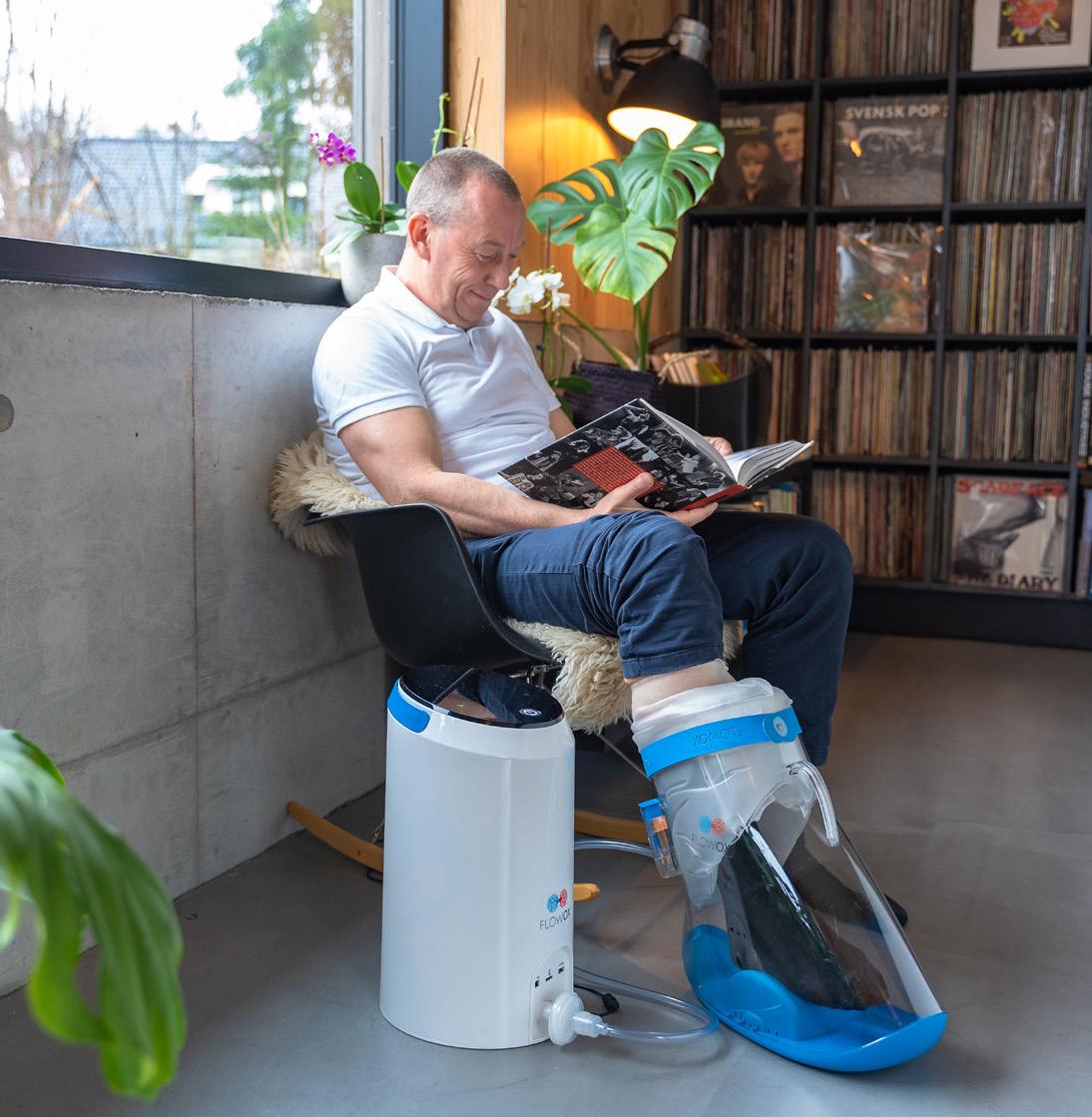
FlowOx™................................................06
The quality of life and costs of reduced microcirculation...............08
The Fontaine classification ...........10
Clinical Data and Evidence
FlowOx™ is a non-invasive treatment, designed for patients to operate in their own homes.
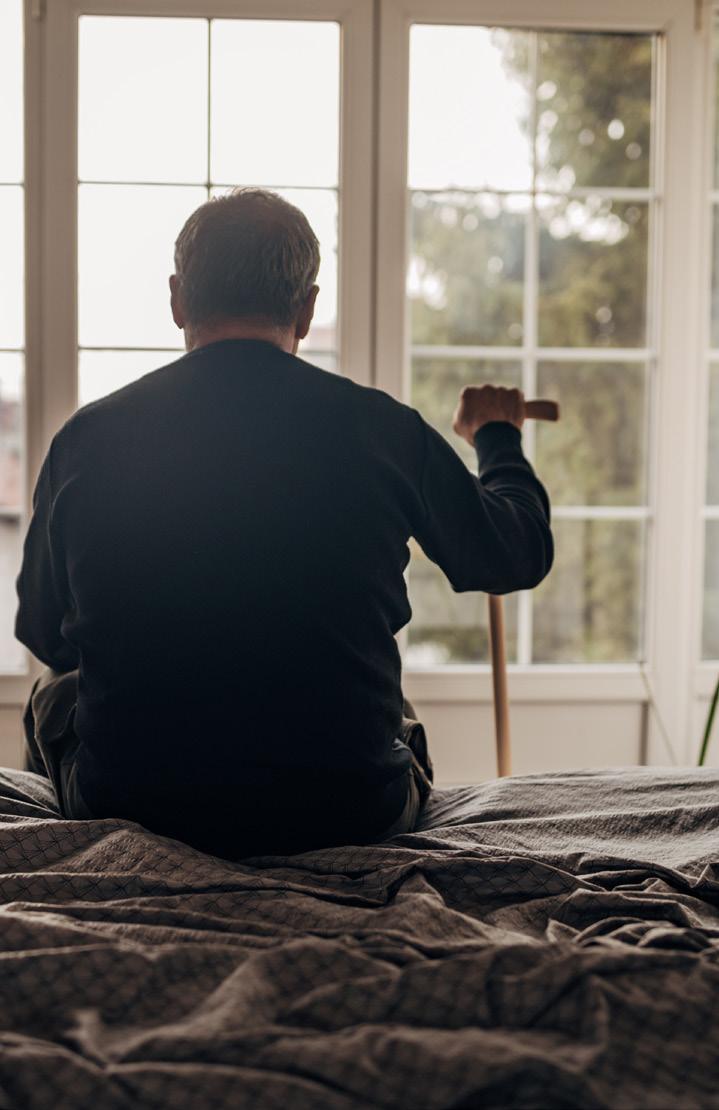
FlowOx™ the Technlogy........................12
FlowOx™ the Equipment.......................14
FlowOx™ the Treatment.........................16
Through the years, the science behind the mechanisms of action with FlowOx™ have been carefullly studied. In this brochure we present the key reports and studies.
The scientific journey.................20
Studies on the acute effect of INP therapy on blood flow parameters.............................22
Blood flow parameters with INP mechanism of action with FlowOx™ ..................................24
Treament with intermittent negative pressure (INP) for intermittent claudication A randomized controlled trial (RCT) ............................................28
Impact on secondary clinical endpoints wound healing & leg ulcers........................32
Read more at www.dmedical.no
Flow mediated dilation & shear stress mechanism of action with FlowOx™................26
Published papers on FlowOx™ and INP..........................35
FlowOx™ is an Intermittent Negative Pressure Therapy
FlowOx™ is a revolutionary new technology for the treatment of reduced peripheral circulation. The technology is based on a tested and gentle intermittent negative pressure technology.

A non-invasive, non-sterile medical device, designed for patients to operate in their own homes.
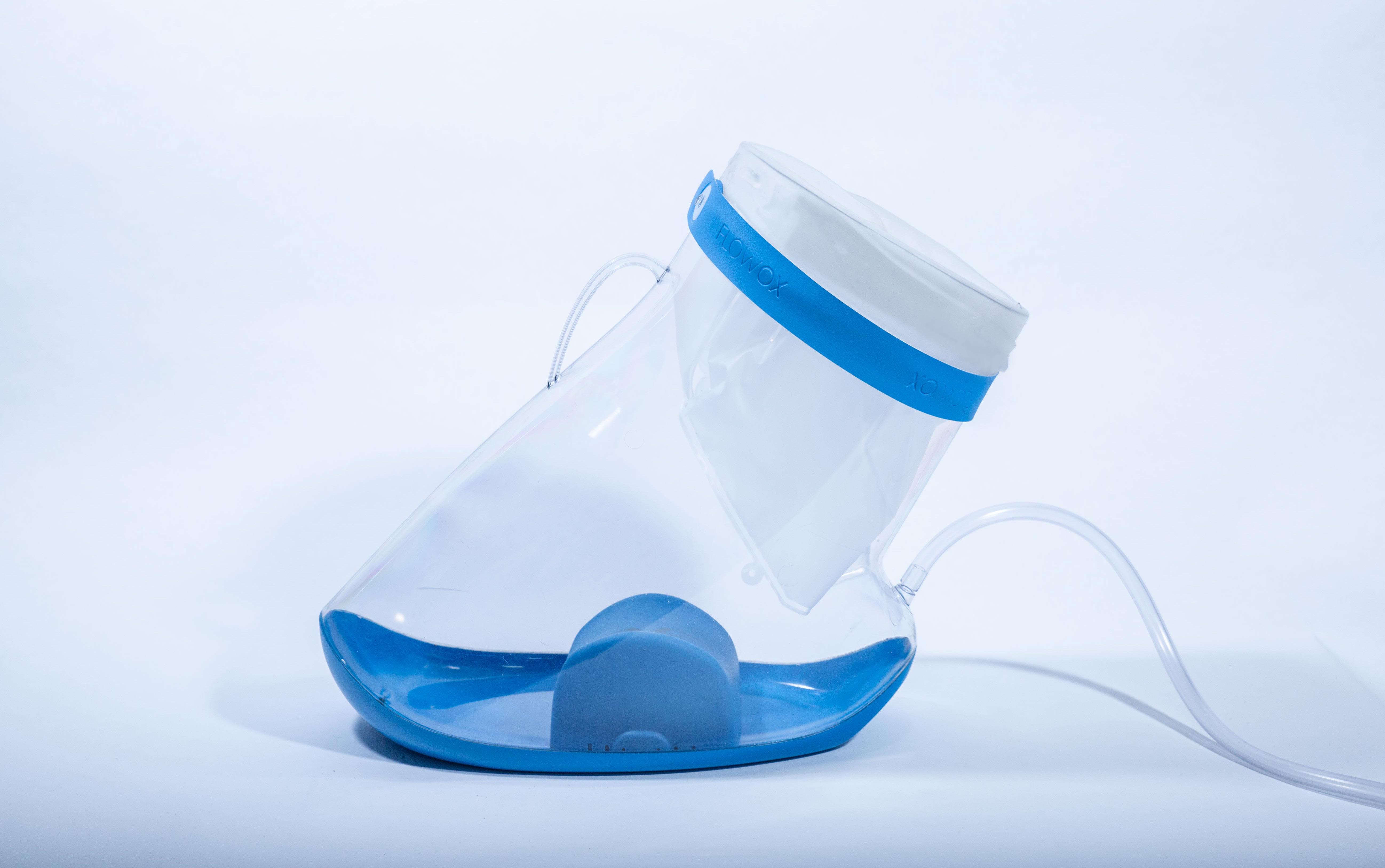
Which patients
Can benefit from FlowOx™?
FlowOx™ is indicated for the treatment of the following conditions in adults over the age of 18:
1. Peripheral Arterial Disease (PAD) such as Intermittent claudication, rest pain or wounds.
2. Diabetic and non-diabetic arteriophatic foot- and leg ulcers
3. Foot and lower leg ulcers of mixed aetiology associated with immobility such as paraplegia following spinal injury
Peripheral Arterial Disease (PAD)
Severe cases of narrowing or blockage of the arteries in the legs or lower extremities
CLINICAL BACKGROUND
Arteriosclerosis
Arteriosclerosis occurs when the blood vessels that carry oxygen and nutrients from the heart to the rest of the body (arteries) become thick and stiff — sometimes restricting blood flow to the organs and tissues. Healthy arteries are flexible and elastic.
This buildup of plaque, also known as atherosclerosis, narrows or blocks blood flow, reducing circulation of blood to the legs, feet, or hands.
Peripheral Arterial Disease
PAD is a common circulatory problem in which narrowed arteries reduce blood flow to the limbs. When developing PAD, the extremities — usually the legs — does not receive enough blood flow to keep up with the demand.
Intermittent Claudication
Claudication is pain caused by too little blood flow to muscles during exercise. Most often this pain occurs in the legs after walking at a certain pace and for a certain amount of time — depending on the severity of the condition. The pain usually isn't constant, it begins during exercise and ends with rest.
Critical Limb Ischemia (CLI) explain Chronic
CLI is the advanced stage of PAD, which results from a progressive thickening of an artery's lining (caused by a buildup of plaque).
Arteriosclerosis is the main cause for PAD. PAD may be asymptomatic, or symptomatic causing intermittent claudication or critical limb ischemia (CLI).
The clinical defintion of CLI is rest pain and/or arterial wounds. This is a severe form of the disease where there is a significant reduction in blood flow to the limbs, which can lead to tissue death, gangrene, and amputation.
CLI is classified as a medical emergency and requires immediate intervention to restore blood flow and prevent further complications.
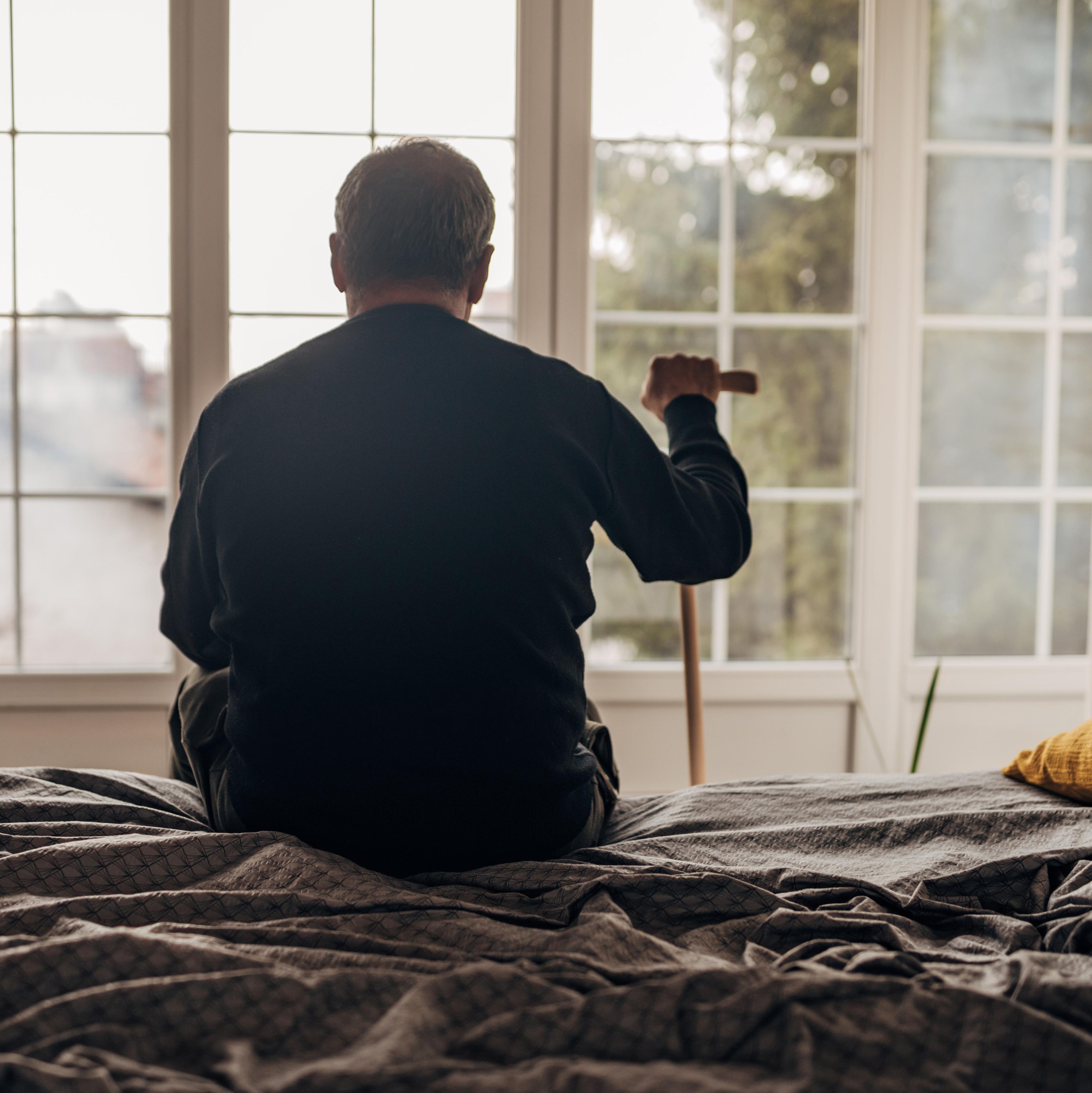
4,000 Surgical procedures per year
NOK 100 000 Per patient annually
800 Amputations per year
NOK 500-800 million Annual amputation cost
What problems are caused by ischemia?
Ischemia is lack of oxygen and other nutrients, and reduced removal of metabolites, due to reduced blood flow. This condition can cause pain, and lead to unhealing wounds and gangrene.
Reduced quality of life
Living with ischemia and having a chronically poor peripheral circulation has shown a significant and accelerating negative impact on patients’ quality of life.
The condition causes patients to struggle with discomfort, pain and a lack of mobility. This results in an increasing use of pain medication and a limited ability to engage in physical activities. Additionally, this patient group has limited options for treatment (often limited to palliative care).

Financial challenges
The financial burden of treating patients with insufficient peripheral microcirculation is extensive and increasing:
The annual cost of treating chronic wounds in home care amounts to NOK 100,000 per patient1
Approximately 4,000 surgical procedures (revascularizations) are performed on patients with reduced peripheral blood circulation. The number is increasing by about 5% per year.2
More than 800 amputations are carried out annually in Norway and the cost of this is NOK 500-800 million.3
It is expected that the societal cost of reduced macro- and microcirculation will increase significantly with the aging population and the increased prevalence of patients with diabetes.
What are the effects of reduced macro- and microcirculation?
Microcirculation is the blood flow through the smallest arteries in the circulatory system.
Macrocirculation is the circulation of blood to and from the organs, as distinguished from microcirculation.
Reduced macro- and microcirculation can lead to lack of nutrition, oxygenation, and reduced removal of metabolites from the tissue.
This may cause the following:
• Ischemic pain
• Reduced local immune function and thereby increased risk of infections
• Reduced ability to produce collagen and thereby limiting the tissue’s ability to heal itself.
Collectively, this reduces the body’s ability to form new blood vessels and its ability to heal wounds.
Over time, the condition will become chronic and progressive, increasing the need for long term pain management, wound healing, and palliative care. The condition often deteriorates to a stage where amputation is inevitable.
Sources
1. Jorunn Hagen Rønsen; UiO 2012: Costs for the treatment of chronic leg ulcers in home nursing.
2. Wendt K, et al. BMJ Open 2017;7
3. Otivio.
The Fontaine Classification
The most used classifications of lower extremity PAD are Fontaine and Rutherford.
The Treatment Stages of PAD
Following the Fontaine classification
CLINICAL BACKGROUND
The Fontaine Classification system is a widely used method for categorizing the severity of PAD based on the symptoms experienced by individuals. It was first introduced in 1954 by Dr. Paul Fontaine and has since become a valuable tool for healthcare professionals in diagnosing and managing PAD.
The Classification system includes five stages, ranging from asymptomatic (Stage I) to severe tissue damage (Stage IV). By identifying the stage of PAD, healthcare providers can determine appropriate treatment options and help improve quality of life for those living with the disease.
Stage I: Asymptomatic
No symptoms are present, but there may be evidence of PAD on diagnostic tests.
Stage IIA: Mild claudication
Symptoms include cramping, pain or fatigue in the legs during exercise that improves with rest.
Painfree walking distance > 200 m
Stage IIB: Moderate claudication
Symptoms are similar to Stage IIa, but they are more severe and occur with less exercise.
Painfree walking distance < 200 m
Stage III: Rest pain
Pain occurs in the legs or feet at rest, usually at night, and is relieved by dangling the legs over the side of the bed.
Stage IV: Ulceration or gangrene
The most severe stage, with non-healing wounds or gangrene (tissue death) present in the feet or toes.
It is important to note that not all individuals with PAD progress through all stages, and treatment options may vary based on the severity of symptoms.
Stage I
Diet changes
Exercise
Quit smoking
Secondary preventive drugs
Diet changes
Exercise
Stage IIA
Quit smoking
Secondary preventive drugs
Diet changes
Exercise
Stage IIB
Quit smoking
Secondary preventive drugs
Endovascular or open surgical treatment
Diet changes
Exercise
Stage III
Quit smoking
Secondary preventive drugs
Endovascular or open surgical treatment
Stage IV
Secondary preventive drugs
Endovascular or open surgical treatment
Diet changes
Exercise
Quit smoking
Secondary preventive drugs
Patients can start using FlowOx at this stage, as supplement to standard care.
FlowOx™ is a supplement to standard care. There is a universal scientific consensus that 2/3 patients are unable to attend SET.
FlowOx™ is a supplement to standard care. There is a universal scientific consensus that 2/3 patients are unable to attend SET.
Relevant for patients that are not amenable for endovascular or open surgical treatment.
FlowOx™ is an addition to endovascular treatment when increased risk of restenosis. Supplement after bypass surgery.
FlowOx™ THE TECHNOLOGY
Passive vascular exercise
Increased walking distance
Improved quality of life
FlowOx™ is an Intermittent Negative Pressure Therapy
FlowOx™ is a novel CE Certified, Class IIa Medical Device which improves blood flow to patients’ legs by applying a negative oscillating pressure. It is comfortable, it can be used while patients are at rest and there is no barrier for regular use. It can transiently increase blood flow in lower extremities by about 60% in the small arteries and more than 100% in the capillaries. FlowOx™ is a non-invasive, non-sterile device enabling patients to treat themselves in their own home.
FlowOx™ is a simple to use treatment alternative for both patients and health care institutions.
FlowOx™ helps to improve the quality of life for patients with a lifelong treatment plan with a high number of doctors appointments, i.e. PAD patients who suffer from leg pain and wounds.
FlowOx™ help the medical care by reducing the time and cost spent on PAD patients with a life long treatment plan.
Home Treatment
FlowOx™
Enables active home treatment
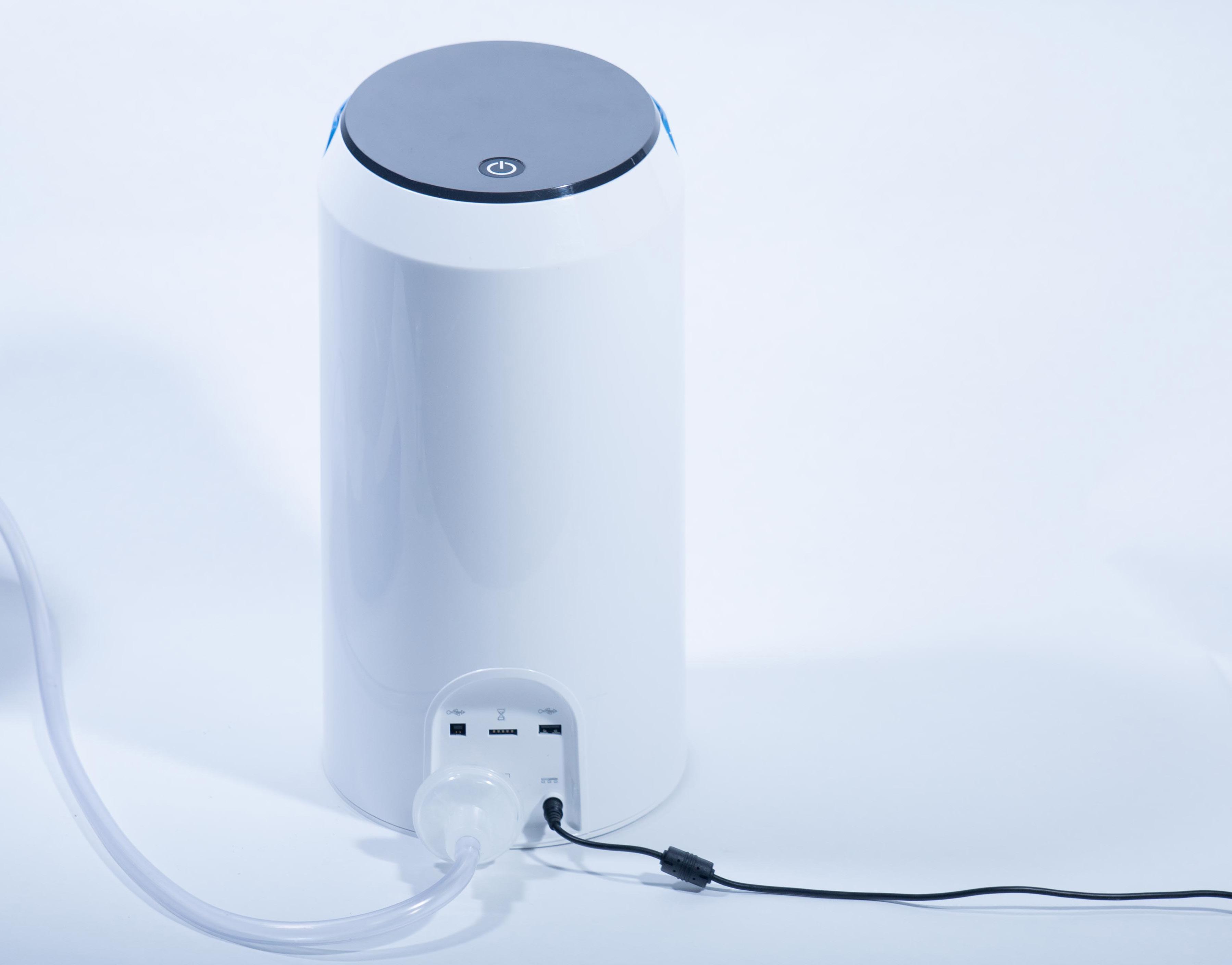
Otivio has developed FlowOx™ for patients suffering from the effects of PAD such as leg pain and chronic wounds. Early long-term testing documents increased blood flow, pain reduction, wound healing and amputation prevention.
Home Treatment
FlowOx™ is large for a boot, but small for a medical appliance. It is perfectly fine to use at home, and can easily be tidied away if needed. It is also easy to use simply with the press of a button, so no assistance is needed.
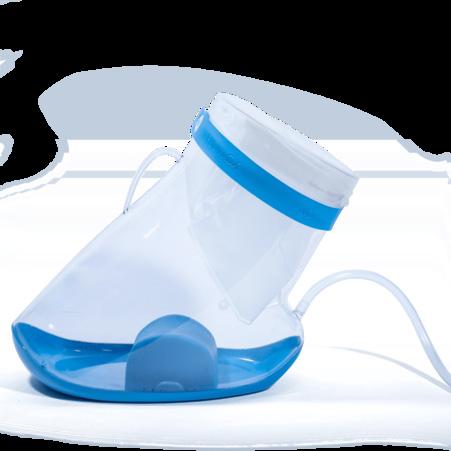
The Technology
Intermittent Negative Pressure (INP)
• Intermittent negative pressure (evacuating 5% of the air, -40mmHg)
• Intermittent suction draws blood to the leg and skin while allowing blood to return during the normal pressure phase (0 mmHg)
FlowOx™ Equipment
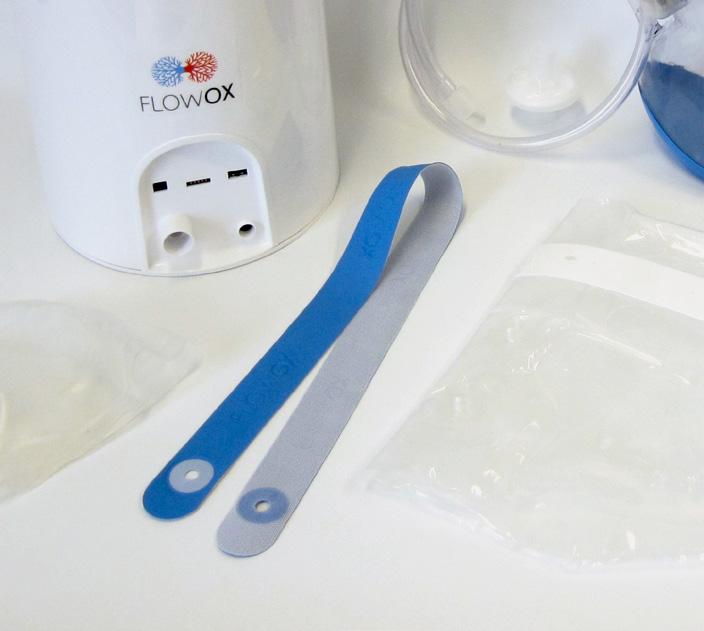
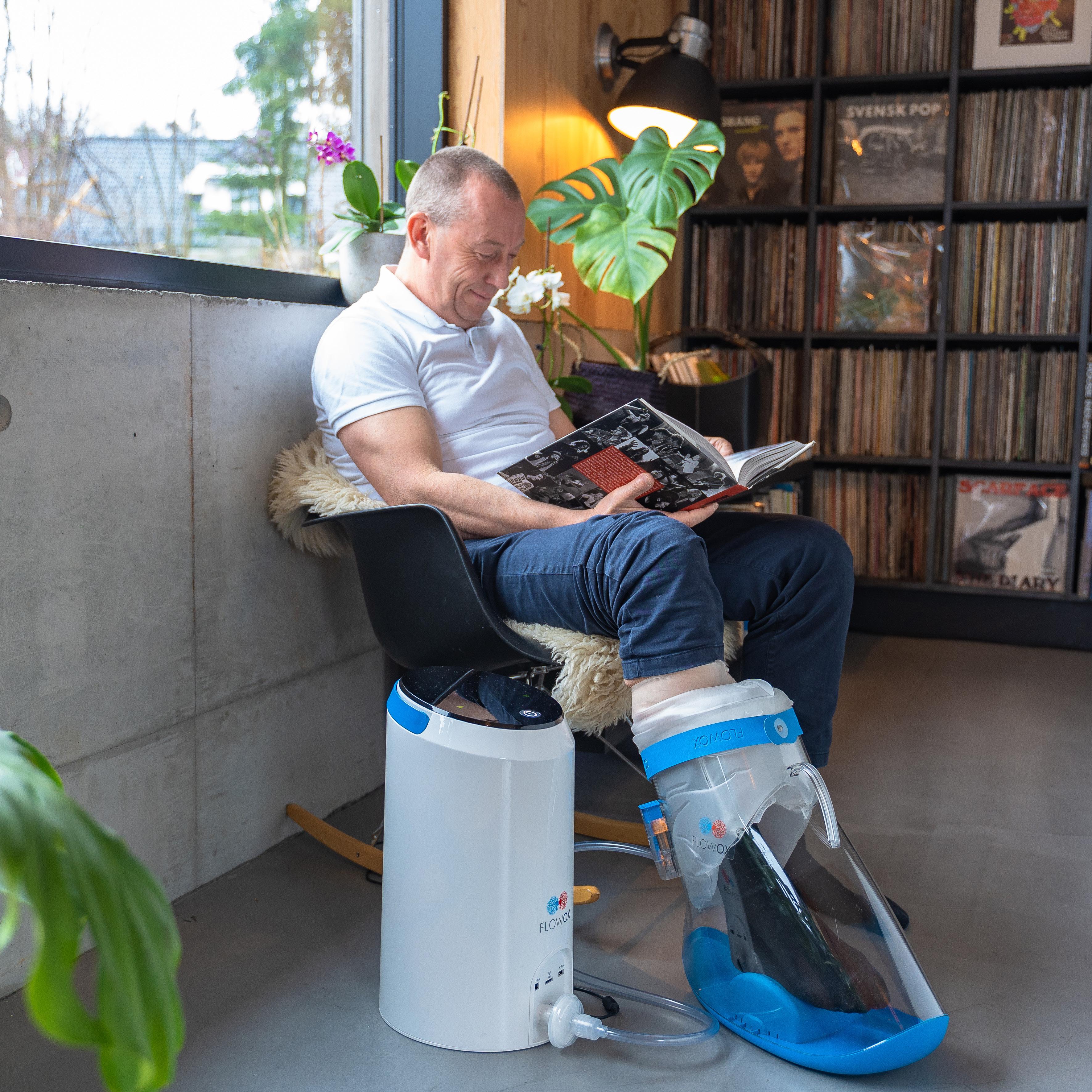
A non-invasive home treatment solution
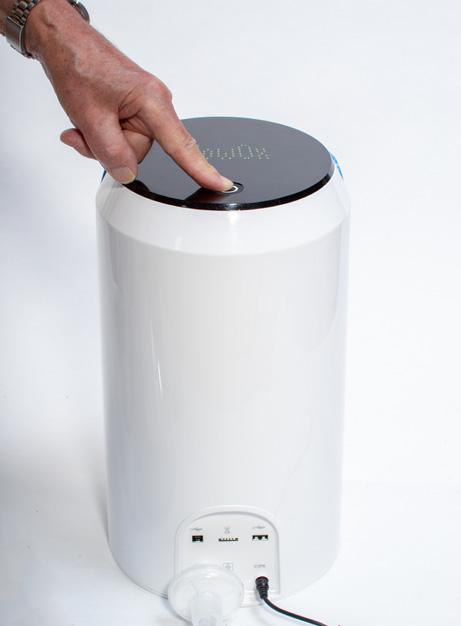
FLOWOX ™
Control Unit
Multi patient use - multiple treatment cycles
Technical Specs
Pressure Chamber (Boot): Single patient use –multiple treatment cycles

Consumables
Strap, seal, padding are consumables that will need to be replaced after each treatment cycle – 180 hours.
• Control Unit (CU) 2,9 kg
• Packaged CU 4,5 kg (incl. power supply)
• Dimension Packed CU 38 x 35 x 56 cm
• Pressure Chamber (PCH) 2,1 kg
• Packaged PCH 4,5 kg (incl. assembly parts)
• Dimension Packed PCH 57 x 31 x 48 cm
How
How?
Through repeating shifts between a light negative pressure (-40 mm Hg) and normal atmospheric pressure, the natural dynamics and function of the vascular system is exercised. Everything from the arteries to the capillaries in the outer layers of the skin experience the fluctuations and thereby improving supply of oxygen and nutrients which is essential for maintaining and restoring the normal function of the skin and musculature.
FlowOx™ thus addresses the underlying problems caused by poor peripheral circulation.
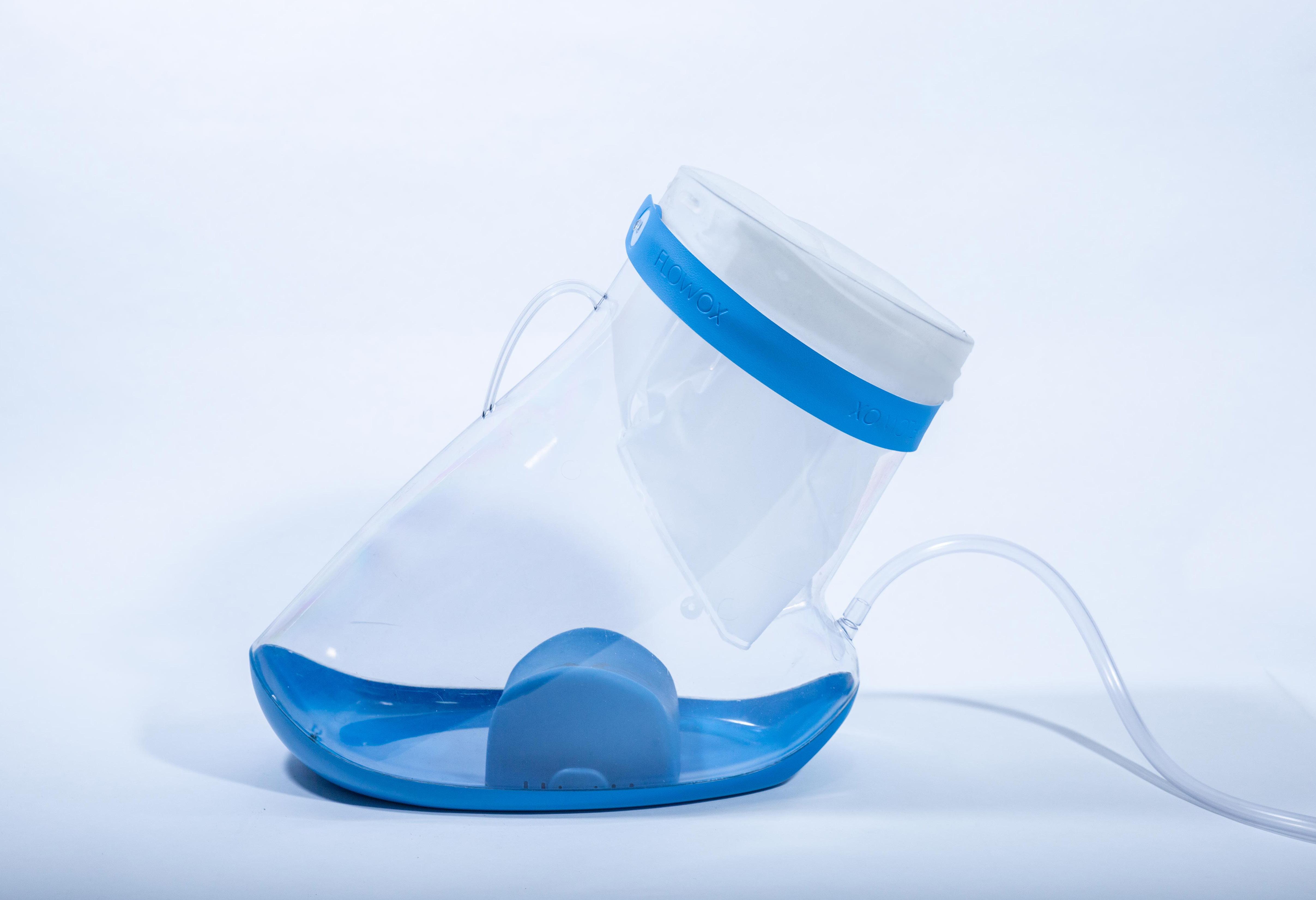
Intermittent negative pressure applied by FlowOx™.
Clinical Data and Evidence
FlowOx™, INP Therapy, Blood Flow
Blood Flow
Flow Mediated Dilation and Shear Stress
Improved walking capacity
The mechanisms of action of FlowOx™ have been carefully studied through the years
FlowOx™ is indicated for the treatment of Peripheral Arterial Disease (PAD), e.g. with intermittent claudication or rest pain, and/or wounds. Other relevant indications include foot and lower leg ulcers of mixed aetiology associated with immobility such as paraplegia following spinal injury, and diabetic and non-diabetic arteriopathic foot and leg ulcers.

Early long-term testing documents increased blood flow, pain reduction, wound healing and amputation prevention.
Here is a selection of the most relevant studies.
• The acute effect of INP Therapy on Blood Flow Parameters
• The Scientific Journey of FlowOx™
• Blood flow parameters with INP Mechanism of action with FlowOx™
• Flow Mediated Dilation & Shear Stress Mechanism of action with FlowOx™
• Improved walking capacity: Publications of the impact on primary clinical endpoints




